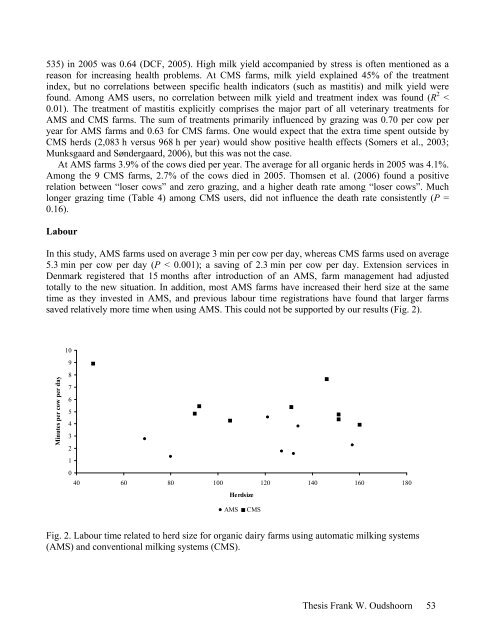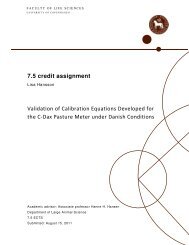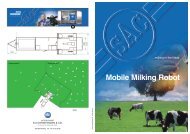Innovative Technology and Sustainable Development of Organic - 1.
Innovative Technology and Sustainable Development of Organic - 1.
Innovative Technology and Sustainable Development of Organic - 1.
You also want an ePaper? Increase the reach of your titles
YUMPU automatically turns print PDFs into web optimized ePapers that Google loves.
535) in 2005 was 0.64 (DCF, 2005). High milk yield accompanied by stress is <strong>of</strong>ten mentioned as a<br />
reason for increasing health problems. At CMS farms, milk yield explained 45% <strong>of</strong> the treatment<br />
index, but no correlations between specific health indicators (such as mastitis) <strong>and</strong> milk yield were<br />
found. Among AMS users, no correlation between milk yield <strong>and</strong> treatment index was found (R 2 <<br />
0.01). The treatment <strong>of</strong> mastitis explicitly comprises the major part <strong>of</strong> all veterinary treatments for<br />
AMS <strong>and</strong> CMS farms. The sum <strong>of</strong> treatments primarily influenced by grazing was 0.70 per cow per<br />
year for AMS farms <strong>and</strong> 0.63 for CMS farms. One would expect that the extra time spent outside by<br />
CMS herds (2,083 h versus 968 h per year) would show positive health effects (Somers et al., 2003;<br />
Munksgaard <strong>and</strong> Søndergaard, 2006), but this was not the case.<br />
At AMS farms 3.9% <strong>of</strong> the cows died per year. The average for all organic herds in 2005 was 4.1%.<br />
Among the 9 CMS farms, 2.7% <strong>of</strong> the cows died in 2005. Thomsen et al. (2006) found a positive<br />
relation between “loser cows” <strong>and</strong> zero grazing, <strong>and</strong> a higher death rate among “loser cows”. Much<br />
longer grazing time (Table 4) among CMS users, did not influence the death rate consistently (P =<br />
0.16).<br />
Labour<br />
In this study, AMS farms used on average 3 min per cow per day, whereas CMS farms used on average<br />
5.3 min per cow per day (P < 0.001); a saving <strong>of</strong> 2.3 min per cow per day. Extension services in<br />
Denmark registered that 15 months after introduction <strong>of</strong> an AMS, farm management had adjusted<br />
totally to the new situation. In addition, most AMS farms have increased their herd size at the same<br />
time as they invested in AMS, <strong>and</strong> previous labour time registrations have found that larger farms<br />
saved relatively more time when using AMS. This could not be supported by our results (Fig. 2).<br />
Minutes per cow per day<br />
10<br />
9<br />
8<br />
7<br />
6<br />
5<br />
4<br />
3<br />
2<br />
1<br />
0<br />
40 60 80 100 120 140 160 180<br />
Herdsize<br />
AMS CMS<br />
Fig. 2. Labour time related to herd size for organic dairy farms using automatic milking systems<br />
(AMS) <strong>and</strong> conventional milking systems (CMS).<br />
Thesis Frank W. Oudshoorn 53




